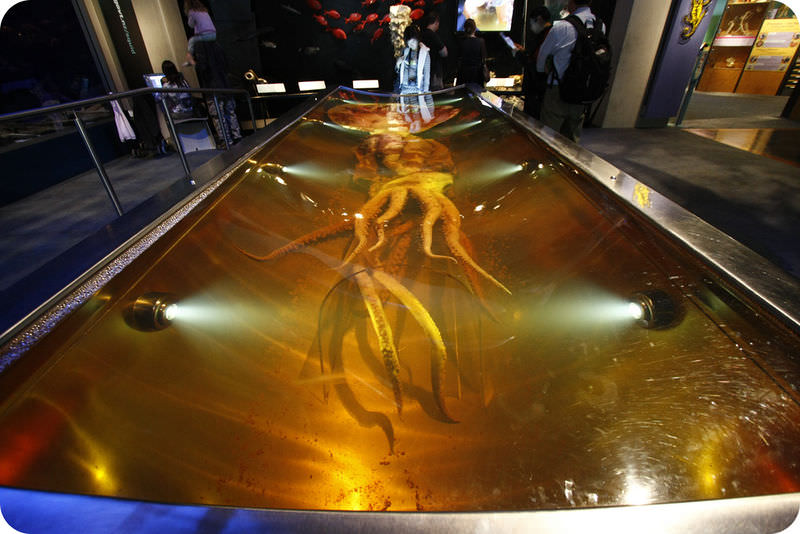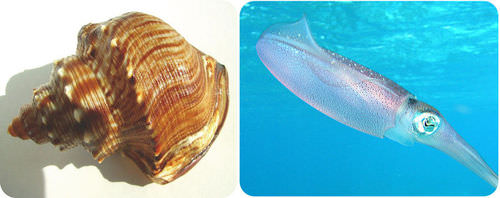9.8 软体动物类型
章节大纲
-
What's the world's largest ?
::什么是世界最大的?The colossal squid, one of the largest invertebrates , measures 14 feet in length here. Some of these squids are even larger and can grow up to almost 50 feet long! The smallest mollusks are snails that are microscopic in size.
::巨型鱿鱼是最大的无脊椎动物之一,其长度为14英尺。有些鱿鱼甚至更大,长近50英尺。最小的软体动物是缩微镜状的蜗牛。Types of Mollusks
::软体类There are approximately 160,000 living species and probably 70,000 extinct species of mollusks. They are typically divided into ten classes, of which two are extinct. The major classes of living mollusks include gastropods , bivalves , and cephalopods ( Figure ).
::有大约160,000个活物种和大约70,000个灭绝的软体动物物种,它们通常分为10类,其中2类已经绝种。 主要活软体动物包括胃肠、双valves和大鼠(Figure ) 。Gastropods
::气气管Gastropods include snails and slugs. They use their foot to crawl. They have a well-developed head. There are many thousands of species of sea snails and sea slugs, as well as freshwater snails, freshwater limpets, land snails and land slugs. Gastropods live in many diverse habitats , from gardens to deserts and mountains. They also live in rivers, lakes and the ocean. Most shelled gastropods have a one-piece shell that is typically coiled or spiraled, but not all gastropods have shells. Gastropods have no sense of hearing , but they can see and have a keen sense of smell . In land-based gastropods, the olfactory organs (for smell) are the most important. These are located on the tentacles.
::气球包括蜗牛和鼻涕,它们用脚来爬行,它们的头很发达,有成千上万种海蜗牛和海鼻,还有数千种淡水蜗牛、淡水瘸子、陆地蜗牛和陆鼻虫。气球生活在从花园到沙漠和山岳等许多不同的生境中,它们也生活在河流、湖泊和海洋中。大多数被炮击的气球有一个单件的外壳,一般是缠绕的或螺旋的,但不是所有的气球都有贝壳。气球没有听觉感,但能看见并且有敏锐的嗅觉。在陆基气球中,嗅觉器官(嗅觉)是最重要的。它们位于触角上。Bivalves
::双马Bivalves include clams, scallops, oysters, and mussels. As their name implies, they have two parts of their shell, which can open and close. Bivalves live in both marine and freshwater habitats. Most bivalves have a pair of large gills that enable them to extract oxygen from the water (to breathe) and to capture food. Water is drawn into the bivalve and washes over the gills. Mucus on the gills helps capture food and cilia transfer the food particles to the mouth. Once in the mouth, food passes into the stomach to be digested. Bivalves have a mouth, heart, intestine, gills, and stomach, but no head. Bivalves have a muscular foot, which in many species such as clams, is used to anchor their body to a surface or dig down into the sand.
::双壳包括蛤、 扇贝、 牡蛎和贝类。 正如它们的名字所暗示的那样, 它们有两部分的外壳, 可以打开和关闭。 双壳生活在海洋和淡水生境中。 多数双壳都有一对大刺, 使他们能够从水中提取氧气( 呼吸) 和捕捉食物。 水被抽进双谷, 在刺上洗涤。 上的粘结有助于捕捉食物, 将食物颗粒转移到嘴中。 一旦进入嘴里, 食物就会进入胃中消化。 双壳有一个嘴、 心脏、 肠、 刺和胃, 但没有头部。 双壳有肌肉脚, 在许多物种, 如蛤, 用来将其身体固定在地上或挖进沙中。Cephalopods
::Cephalopods include the octopus and squid. They have a prominent head and a well-developed brain . Typically the foot has been modified into a set of arms or tentacles. Members of this class can change color. They can also change texture and body shape, and, and if those camouflage techniques don't work, they can still "disappear" in a cloud of ink. Cephalopods have three hearts that pump blue , they're jet powered by their muscular foot, and they're found in all oceans of the world. Cephalopods are thought to be the most intelligent of invertebrates. They have and other senses that rival those of humans. Many cephalopods are active and efficient predators . What features do you think allows for this?
::和鱿鱼包括章鱼和鱿鱼。 它们有一个突出的脑袋和一个发达的大脑。 通常, 脚被改造成一组手臂或触手。 类中的成员可以改变颜色。 它们也可以改变纹理和身体形状, 并且, 如果这些伪装技术不起作用, 它们仍然可以在墨水云中“ 消失 ” 。 有三个心跳蓝色, 它们用肌肉脚进行喷射, 它们在全世界所有海洋中被发现。 被认为是无脊椎动物中最聪明的。 它们和其他感官比人类更像。 许多天花鼠是活跃和高效的掠食者。 你认为这些特征允许什么?(left) An example of a gastropod species, the ostrich foot. (right) A Caribbean reef squid, an example of a cephalopod.
:左) 食胃动物的一例, 脚。 (右) 加勒比珊瑚礁鱿鱼, 甲状腺动物的一例。
Summary
::摘要-
Mollusks are divided into ten living classes, including the familiar gastropods, cephalopods, and bivalves.
::Mollusks被分为10个活班,包括熟悉的胃腔、头骨和双谷。 -
Mollusks live in marine and freshwater habitats, as well as on land.
::Mollusks生活在海洋和淡水生境以及陆地上。
Explore More
::探索更多Use the resources below to answer the questions that follow.
::利用以下资源回答以下问题。-
Mollusk Animation: Abalone Body Plan
at
(1:22)
::Mollusk 动画:1:22的单独身体计划(1:22)
-
Mollusk Animation: Nautilus Body Plan
at
(2:35)
::Molusk 动画: Nautilus 身体计划(2:35)
-
Mollusk Animation: Squid Body Plan
at
(1:34)
::Mollusk 动画: 在(1: 34)上方的体积平整计划
-
How does the foot compare between abalone, nautilus, and a squid?
::? -
How does the shell of an abalone differ from the shell of a nautilus?
::鲍鱼的外壳 如何与秃鹫的外壳不同? -
How many hearts does a squid have? How do these hearts help the squid?
::鱿鱼有多少颗心脏?这些心脏如何帮助鱿鱼? -
Describe the mantle of a squid.
::描述鱿鱼的地皮。
Review
::回顾-
Name five examples of mollusks.
::举五个软体动物的例子。 -
What habitats do gastropods live in?
::肠胃动物的栖息地是什么? -
What is the defining feature of a bivalve?
::双valve的界定特征是什么? -
What mollusk is thought to be very intelligent?
::哪些软体动物被认为非常聪明? -
Describe the foot of a gastropod, bivalve, and cephalopod.
::描述一个胃腔、双valve和头骨的脚。
-
Mollusks are divided into ten living classes, including the familiar gastropods, cephalopods, and bivalves.

